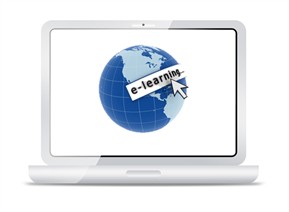Challenges of eLearning Localization with Synchronous eLearning
As mentioned in our previous two blogs, there are cultural limitations in asynchronous learning platforms that can inhibit the achievement of equitable learning outcomes. We first discussed the online platforms, such as Blackboard and WebCTused by many universities. Organizations use these to present content and to manage the learning function. We also discussed eLearning localization and cultural challenges in self-paced courses, which require instructional designers to emulate the ‘live’ environment without the presence of an instructor.

Today, we’ll discuss the localization challenges in the synchronous environment typically manifested in webinars. Webinars are ‘live’ events in which the presenter can choose to lecture to the audience or to interact with them. Examples of webinar platforms are LiveMeeting, Webex, Vyew, etc. In addition, we can include similar synchronous communication tools like Skype in this category, although they are often not as robust with respect to interactivity features. Some of the localization challenges are similar to those found in the asynchronous environments. For example, the content needs to be relevant, contextualized, and in a language the targeted learners can easily understand. Instructional approaches still need to be culturally inclusive, which we’ll revisit in this blog.
However, in webinars, we have additional challenges. First, and of greatest concern to educators, is the challenge of designing the course in a way that is inclusive for members of all cultures. Second, we want our facilitators/instructors to have highly developed cultural skills so they can effectively communicate with members of other cultures. Finally, we need to ensure that the platform is technologically accessiblein other countries.
Course Design and eLearning Localization
The features of webinar platforms inform many aspects of course design. For example, instructors typically present content in a lecture format supported by PowerPoint slides. A lecture format can be very appealing to non-native English speakers because there is limited interaction with the speaker and the PowerPoint slides can support what the speaker is saying. Thus, editing and localizing both the lecture and the slides are important cultural adaptation techniques. For more information about best practices to optimize your PowerPoint documents for translation check PowerPoint Translation.

The instructor can further engage the learners by using polls, chat, whiteboards, or sharing (files, applications, media, or internet sites). While polling is helpful for gathering information, opinions, and attitudes from participants, we recommend a cultural review to ensure clear language usage and to avoid culturally inappropriate questions. The chat feature provides another way to communicate with the instructor and with classmates. The benefit of chat is that it allows non-native English speakers to participate without speaking. The challenge of chat is that these same participants must be able to type well – and often, fast – in a language other than their native one. If you’ve ever tried that, you know it’s difficult! Thus, we recommend several techniques for using chat that overcomes these barriers. Whiteboards allow instructors and participants to collaborate on drawings, lists, and so forth. They present the same challenges encountered when using chat. Lastly, the webinar sharing features are more likely to create technical challenges rather than cultural ones, so we’ll discuss those below.
In contrast to the lecture approach, most webinar platforms offer many opportunities to interact and collaborate. For example, breakout rooms allow participants to work on tasks in small groups, in an electronic version of the way it’s done in face-to-face classrooms. However, many learners in non-U.S. cultures will be unfamiliar with this approach and/or hesitant to participate. For example, learners from hierarchical cultures expect the instructor to be the expert and, subsequently, they do not understand the value of a typical American approach to building knowledge and skills using collaborative activities. In addition, using such activities requires concise instructions. Thus, a cultural analysis of the instructional approach can offer ‘best practices’ and approaches to using webinar collaboration techniques.
Cultural Competence in providing translation services
If you have ever learned a second language, you are familiar with the challenge of listening to someone speak in a non-native language. What helps us, as learners, is to be presented with simple, well-constructed language supported by gestures, tone, and inflection. In fact, if you think about it, you have probablyanalyzed the essence of a conversation in an unfamiliar language – perhaps while watching a movie – in simply by watching the gestures and registering the speakers’ tone and inflection! Thus, using these in webinars contributes to the learners’ understanding of your content. Unfortunately, most American instructors are unaware or forgetful of this need, especially in the online environment where one cannot see other participants! As a translation agency, we cannot control how your instructors speak, but we can edit content to ensure ‘fast digestion’ by non-native English speakers. We can also recommend, via a cultural analysis, how to prepare your instructors for the cross-cultural online environment.

In fact, that leads us to two other skills required of online facilitators: the ability to detect cultural issues and the ability to mediate communications between learners from different cultures. An online instructor needs to recognize, for example, that the learners in China are probably not participating in a group activity because of cultural and language issues; or, that the students in the United Arab Emirates were not cheating on the final exam; instead, they were collaborating with members of their ‘in-group’ to succeed. The instructor also needs to provide opportunities for members of all cultures to communicate their ideas. For example, American learners can easily overpower those from Asian cultures simply because Americans have more direct communication styles. It becomes the instructor’s responsibility to offer other venues of communication in the webinar. With a cultural analysis, we can recommend approaches that specifically align to your learners’ cultural needs and preferences. For more information about culture correctness and the online consumer check out our white papers on Website Globalization and E-Business.
Technological Concerns and professional localization services
We mentioned earlier that webinar platforms could present technological issues. These can occur domestically, but are more prevalent in an international environment. In many cases, the voice-over-IP (VOIP) provided within the webinar platform to support internet-based conversations is not supported by end-user technologies or by international infrastructure; nor is the use of webcams or streaming media. The use of phone lines often poses additional expense to the learners. You as the customer should be aware of these issues and test for them. We cannot rebuild your technology but we can advise you on using alternative techniques. In addition, if you plan to use media, we can help you design and prepare culturally appropriate versions.
Our translation and localization services include:
- Document Translation
- Multilingual Desktop Publishing Services
- Audio/Video Translation
- Software Translation
- Website Translation
- Interpretation Services
- Globalization Consulting Services
- Multilingual Website Design and Development Services
Conclusion: perspective of a localization company
From the perspective of a localization company, we can control only to a limited extent some of the challenges we discussed today. For example, we cannot control the level of cultural competence of your webinar instructors or facilitators. On the other hand, customers often bring course support materials to us, such as facilitator guides, participant workbooks, worksheets, etc. As our customer, you would benefit from a cultural analysis of those materials to mitigate any challenges related to course design before we initiate translation and localization. We are uniquely equipped to provide cultural adaptation to elearning that goes beyond looks and language – we address learning!
eLearning Localization and Translation Services
GPI, a premiere translation company, provides comprehensive localization and translation services for eLearning and training courses. Our elearning localization team will help you translate your elearning courses and presentations in all languages.
